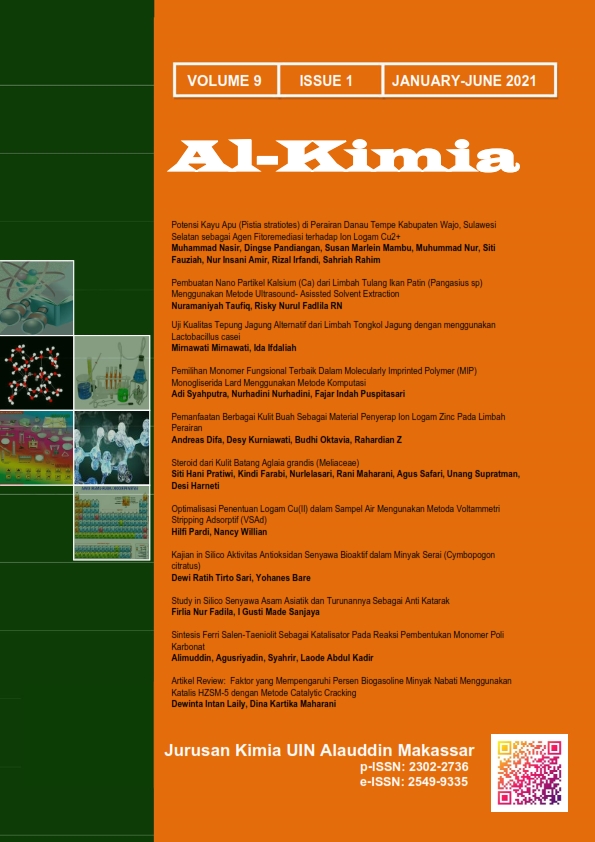Steroid dari Kulit Batang Aglaia grandis (Meliaceae)
Abstrak
Steroids are a group of secondary metabolite which showed various biological activities. Meliaceae is a plant family used as a one of the source of steroid compounds. A. grandis is a member of the Meliaceae family in genus Aglaia which rarely explored. Previous studies have shown that A. grandis leaves contain triterpenoids, steroids, bisamide, and sesquiterpenoids. This study aims to obtain steroids from the bark of A. grandis. The structure of the isolated compound was determined using the NMR 1D and 2 D spectroscopic. Based on the extensive analysis, isolated compound identified as a stigmastant type steroid, stigmast-5-en-3β-ol-7-one.##plugins.generic.usageStats.downloads##
Referensi
Di Gioia, F., & Petropoulos, S. A. (2019). Phytoestrogens, phytosteroids and saponins in vegetables: Biosynthesis, functions, health effects and practical applications. In Advances in Food and Nutrition Research (1st ed., Vol. 90). Elsevier Inc. https://doi.org/10.1016/bs.afnr.2019.02.004
Harneti, D., & Supratman, U. (2021). Phytochemistry and biological activities of Aglaia species. Phytochemistry, 181(October 2020), 112540. https://doi.org/10.1016/j.phytochem.2020.112540
Ii, C. (n.d.). Phytochemical Study of Euphorbia lagascae Results and Discussion.
Inada, A., Murata, H., Inatomi, Y., Nakanishi, T., & Darnaedi, D. (1997). Pregnanes and triterpenoid hydroperoxides from the leaves of Aglaia grandis. Phytochemistry, 45(6), 1225–1228. https://doi.org/10.1016/S0031-9422(97)00145-3
Inada, A., Shono, K., Murata, H., Inatomi, Y., & Darnaedi, D. (2000). 2000-1091 Aglaia grandis.pdf. 53, 1091–1095.
Jaeger, M., & Aspers, R. L. E. G. (2012). Steroids and NMR. In Annual Reports on NMR Spectroscopy (Vol. 77). https://doi.org/10.1016/B978-0-12-397020-6.00003-9
Kashyap, P., Muthusamy, K., Niranjan, M., Trikha, S., & Kumar, S. (2020). Sarsasapogenin: A steroidal saponin from Asparagus racemosus as multi target directed ligand in Alzheimer’s disease. Steroids, 153, 108529. https://doi.org/10.1016/j.steroids.2019.108529
Darwati. (2019). Isolasi Senyawa steroid dari akar tumbuhan asam kandis ( Garcinia cowa Roxb . ex DC )sebagai obat penurun panas ( Steroid Compounds from Root Plant of Acid ( Garcinia cowa Roxb . ex DC ) for Fever Relief ). Jurnal Penelitian Hasil Hutan. 37(1), 51–57.
Priya, R., Sowmiya, P., & Muthuraman, M. S. (2018). An overview on the biological perspectives of aglaia species. Asian Journal of Pharmaceutical and Clinical Research, 11(9), 9–12. https://doi.org/10.22159/ajpcr.2018.v11i9.26436
Weber, S., Puripattanavong, J., Brecht, V., & Frahm, A. W. (2000). Phytochemical investigation of Aglaia rubiginosa. Journal of Natural Products, 63(5), 636–642. https://doi.org/10.1021/np9905923
Yang, M., Cui, W. X., Li, H., Li, S. W., Yao, L. G., Tang, W., Mudianta, I. W., & Guo, Y. W. (2020). Sinulasterols A–C, three new bioactive oxygenated steroids from the South China Sea soft coral Sinularia depressa. Steroids, 157, 108598. https://doi.org/10.1016/j.steroids.2020.108598
Authors who publish with this journal agree to the following terms:
1) Authors retain copyright and grant the journal right of first publication with the work simultaneously licensed under a Creative Commons Attribution License that allows others to share the work with an acknowledgement of the work's authorship and initial publication in this journal.
2) Authors are able to enter into separate, additional contractual arrangements for the non-exclusive distribution of the journal's published version of the work (e.g., post it to an institutional repository or publish it in a book), with an acknowledgement of its initial publication in this journal.
3)Authors are permitted and encouraged to post their work online (e.g., in institutional repositories or on their website) prior to and during the submission process, as it can lead to productive exchanges, as well as earlier and greater citation of published work (See The Effect of Open Access).


